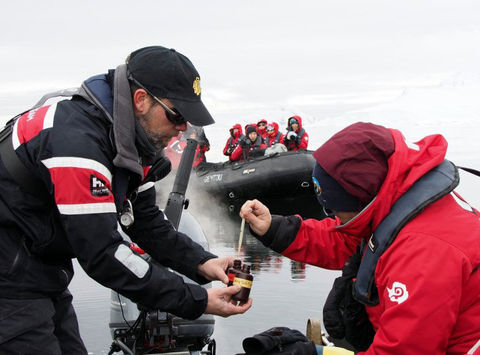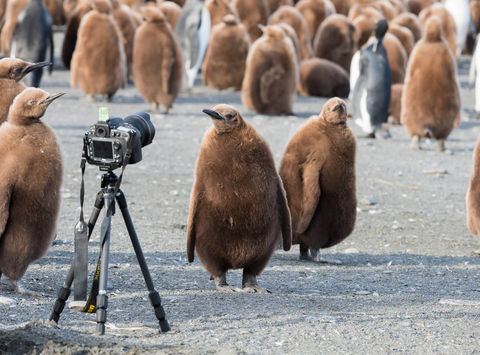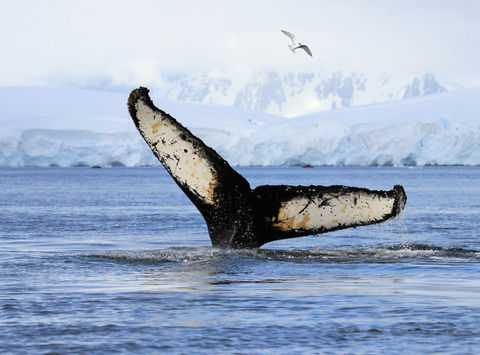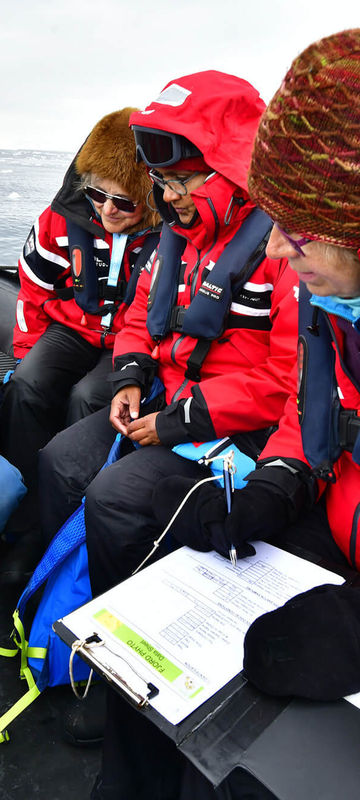Spellbinding beauty, captivating wildlife and a sense of adventure in visiting one of the last true wilderness areas on our planet. That is the simple lure of The Great White Continent.
Antarctica and the sub-Antarctic islands are remote, rugged and endlessly fascinating. The wildlife encounters, particularly with inquisitive penguins, are quietly exhilarating and the scenery is awe-inspiring in its beauty. Zodiac excursions, shore landings and optional activities like kayaking or paddle boarding provide adventure in abundance, while time on board ship provides plenty of moments of quiet contemplation.
The chance to experience this special region on an adventure cruise is both a privilege and an inspiration, and now also an opportunity to give back by getting involved in scientific research during your voyage.
Citizen science – where you help scientists collect data that feeds into important research projects –gathers valuable data for making informed decisions about urgent issues like climate change and wildlife conservation. In the words of one citizen scientist, “It gave the trip more purpose.” Another said, “I had heard of the beauty of Antarctica, but being part of understanding it better made an impact. It made me want to be an ambassador for Antarctica…”

How do you become a citizen scientist?
It’s simple really. All of our polar voyage partners operate citizen science programmes on their ships. Fun, interactive and informative, they are completely voluntary and no prior scientific knowledge is required. It’s about sharing new discoveries and deepening your connection to the natural world with small groups of like-minded people.
On their own, your observations might not seem like much – but imagine the wealth of data collected by thousands of polar voyagers, like yourself, over several years… it all adds up to serious data that scientists can combine with their own research.
What will you be doing as a citizen scientist?
One day you might be surveying penguins or tracking the migratory behaviour of whales, the next you could be mapping cloud patterns or measuring ocean temperatures in support of climate research.
Some of our expedition ships, such as Seaventure and Sylvia Earle even have onboard laboratories.
On a typical citizen science programme, you will usually be invited to participate in at least one session on most days – dovetailing with other activities, such as shore landings and Zodiac excursions. A typical day might involve a seabird count at 14:00 and a cloud survey at 18.00. Or you might be photographing whales and noting their unique markings. In addition, a citizen science co-ordinator will arrange short lectures. It all adds an extra dimension to what is already the trip of a lifetime.

What difference does citizen science make?
Take two examples from Polar Latitudes (the first to offer citizen scientist projects in the polar regions), and their vessel the Seaventure: citizen scientists studying cloud formations in Antarctica have provided a great deal of information about how global warming is profoundly impacting climate change, not just in Antarctica, but all over the world. Just a few readings taken during the course of each voyage have resulted in a wealth of data. Thousands of whale fluke photos taken by citizen scientists, meanwhile, provided data that was crucial to the creation of a 20,000-sq-km slow-down zone to reduce ship strikes.
What are specific citizen science projects offered?
Several of our expedition partners, including AE Expeditions, Intrepid Travel, Polar Latitudes and Poseidon Adventure, use citizen science to support the Happywhale programme. Whale identification photography feeds into software which compares unique markings to track individual cetaceans and learn about their migratory behaviour, social dynamics and population health. With expert guidance, you’ll focus on characteristic markings of humpback whale flukes and the dorsal fins and saddle patches of orcas.
NASA’s Globe Observer – tracking changes in clouds in support of climate research – is another fascinating citizen science project that you can take part in. You’ll record cloud cover, height and type which NASA then uses for comparison to similar information obtained from its satellites.
Phytoplankton is a crucial component of the food chain in polar regions, and by collecting samples you will be supporting the FjordPhyto project to help researchers better understand its abundance and distribution throughout the summer growing season. The Secchi Disk Foundation (named after the white disk that measures the clarity of seawater) also benefits from citizen science surveys of phytoplankton on polar voyages.
Other projects include seabird counts to support long-term monitoring of penguins, albatrosses, auks, terns and puffins. Quark Expeditions, for example, supports Seabird Watch, a citizen science initiative that uses time-lapse cameras to monitor seabird colonies in Svalbard, Iceland, Greenland and other parts of the Arctic.
From shoreline sampling for The Big Microplastic Survey to observations of ice thickness, age and degree of melt for the Ice Watch project, citizen scientists are at the forefront of research. Take part and you’ll be making a real difference.

Feeling inspired?
You can join Citizen Science projects on a wide range of our small-ship expedition voyages to the Arctic and Antarctic including our Classic Antarctica, Peninsula, Falklands and South Georgia and Around Spitsbergen voyages. Contact our Polar Travel Specialists on 01737 214 250 or send an enquiry to discuss voyage options.
There are often multiple chances to collaborate on different projects during your voyage and on-board Citizen Science coordinators will keep you posted on the projects you can participate in each day.
If you join a voyage to Svalbard you’ll also be able get involved in the Clean up Svalbard program. The simple goal – pick up marine debris as it’s spotted on shore visits around the archipelago.
























